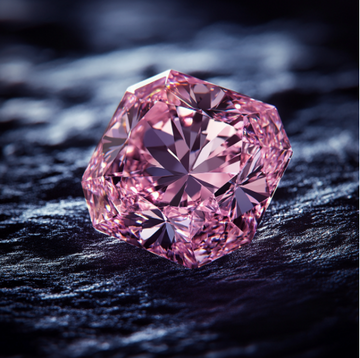The question itself seems almost absurd. A pink diamond? Isn’t it just a colored stone trying to masquerade as the real deal? The short answer is a resounding YES! A pink diamond is a real diamond. However, the nuances of why and how these blush-toned beauties exist are fascinating and often misunderstood. Let’s cut through the confusion and delve into the captivating world of pink diamonds, clarifying their authenticity and exploring what makes them so special.
I. What Defines a “Real” Diamond? The Core Criteria
To understand why pink diamonds are undeniably “real,” we first need to establish the criteria for what constitutes a genuine diamond in the first place. A real diamond meets the following requirements:
- Chemical Composition: Primarily composed of pure carbon atoms (symbol C).
- Crystal Structure: Atoms arranged in a specific cubic crystal lattice.
- Hardness: Exceptional hardness, registering a 10 on the Mohs scale (the highest possible rating).
- Optical Properties: Exhibit brilliance (internal reflection of light), fire (dispersion of light into spectral colors), and scintillation (surface sparkle).
II. Pink Diamonds Meet the Criteria: Dispelling the Myths
A pink diamond, whether naturally occurring or created in a laboratory, fulfills all the criteria listed above. Therefore, it is unequivocally a real diamond. The pink color is simply an attribute – an additional characteristic – that does not negate its fundamental diamond properties.
It’s important to understand that the “realness” of a diamond doesn’t depend on its color. Just as yellow, blue, or green diamonds are considered real, so too are pink diamonds.
III. The Origin of Pink Color: Not an Impurity, But a Twist of Fate
The captivating pink hue in pink diamonds is not typically due to chemical impurities like nitrogen (yellow diamonds) or boron (blue diamonds). Instead, it’s believed to result from a structural anomaly within the diamond’s crystal lattice known as plastic deformation.
- Plastic Deformation Explained: During the diamond’s formation billions of years ago, intense pressure and heat caused the crystal structure to become distorted. These distortions – a type of “slip” in the atomic arrangement – cause the diamond to absorb light differently, resulting in the pink coloration.
Think of it like bending a piece of metal. The bending changes the metal’s structure, causing it to behave differently. Similarly, the plastic deformation in a pink diamond alters its light absorption properties, resulting in its unique color.
IV. Natural vs. Lab-Grown Pink Diamonds: Both Are Real, But Differently Sourced
A crucial point to understand is that “real” diamonds can be sourced from two places:
- Natural Diamonds: Mined from the Earth, formed billions of years ago through natural geological processes. These diamonds can be pink due to the aforementioned plastic deformation.
- Lab-Grown (Synthetic) Diamonds: Created in a laboratory setting using advanced technology (HPHT or CVD) that mimics the natural diamond-forming process. Lab-grown diamonds can also be pink, achieved through controlled processes during growth (creating nitrogen vacancies) or through post-growth treatments (irradiation and annealing).
Both natural and lab-grown pink diamonds are real diamonds because they meet the fundamental criteria of chemical composition, crystal structure, hardness, and optical properties. The key difference lies in their origin and how their color is achieved.
V. Importance of Certification: Ensuring Authenticity and Disclosure
Regardless of whether a pink diamond is natural or lab-grown, it’s crucial to obtain a gemological certificate from a reputable laboratory (GIA, IGI, AGS). This certificate will:
- Verify Authenticity: Confirm that the stone is indeed a diamond.
- Disclose Treatment: Indicate whether the diamond has been treated in any way to enhance its color.
- Identify Origin: Clearly state whether the diamond is natural or lab-grown.
- Grade the Color: Assign a color grade that describes the intensity and hue of the pink color (e.g., Faint Pink, Fancy Light Pink, Fancy Vivid Pink).
- Assess Clarity: Evaluate the diamond’s clarity based on the presence and visibility of inclusions (internal imperfections).
- Determine Cut: Assess the quality of the diamond’s cut, which affects its brilliance, fire, and scintillation.
VI. Pink Diamonds: Rare Treasures Worthy of Admiration
Whether it’s a natural marvel formed over millennia or a technologically advanced creation, a pink diamond is a genuine diamond with a captivating story to tell. Their unique color, exceptional properties, and relative rarity make them highly prized and cherished gemstones. So, the next time you encounter a pink diamond, appreciate it for what it truly is: a genuine diamond with a distinct and beautiful personality. They are a testament to the power of nature or the ingenuity of human innovation.







